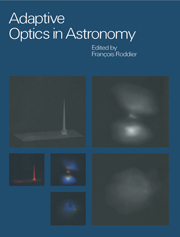Book contents
- Frontmatter
- Contents
- List of contributors
- Part one Introductory background
- Part two The design of an adaptive optics system
- Part three Adaptive optics with natural guide stars
- Part four Adaptive optics with laser beacons
- Part five The impact of adaptive optics in astronomy
- 14 Observing with adaptive optics
- 15 Astronomical results
- 16 Future expectations
- Glossary of acronyms
- Index
15 - Astronomical results
from Part five - The impact of adaptive optics in astronomy
Published online by Cambridge University Press: 23 November 2009
- Frontmatter
- Contents
- List of contributors
- Part one Introductory background
- Part two The design of an adaptive optics system
- Part three Adaptive optics with natural guide stars
- Part four Adaptive optics with laser beacons
- Part five The impact of adaptive optics in astronomy
- 14 Observing with adaptive optics
- 15 Astronomical results
- 16 Future expectations
- Glossary of acronyms
- Index
Summary
In this chapter we present astronomical observations obtained, at unprecedented high resolution, with the first adaptive optics systems installed on large telescopes and producing images of scientific value on a regular basis. These images cover many of the objects of interest to astronomers, from planets to quasars, and involve a number of approaches: straight imaging, spectroimaging, polaro-imaging, coronography, all being done in wide or narrow fields. These results have been obtained less than seven years after the very first astronomical AO image was taken in 1989, we hope they will convince the reader of the great future adaptive optics should have in astronomy.
Scientific programs with adaptive optics
Astronomers rightly insist upon covering various spectral ranges with similar performance in terms of sensitivity and angular resolution. On Fig. 15.1 the performance of AO is compared with that of existing or planned space-borne telescopes and ground-based telescope arrays from near ultraviolet to millimetric wavelengths. It is worth nothing the interesting match between the Hubble Space Telescope (HST) diffraction limit and the current AO systems on large telescopes, as will be demonstrated in several examples in this chapter. It is also apparent that AO observations provide the intermediate and necessary step between seeing limited images and multi-telescope interferometric observations. Optical interferometers provide the next step in improved angular resolution by one to two orders of magnitude, but require ‘identification maps’ of intermediate resolution, that AO observations can produce.
- Type
- Chapter
- Information
- Adaptive Optics in Astronomy , pp. 371 - 398Publisher: Cambridge University PressPrint publication year: 1999



